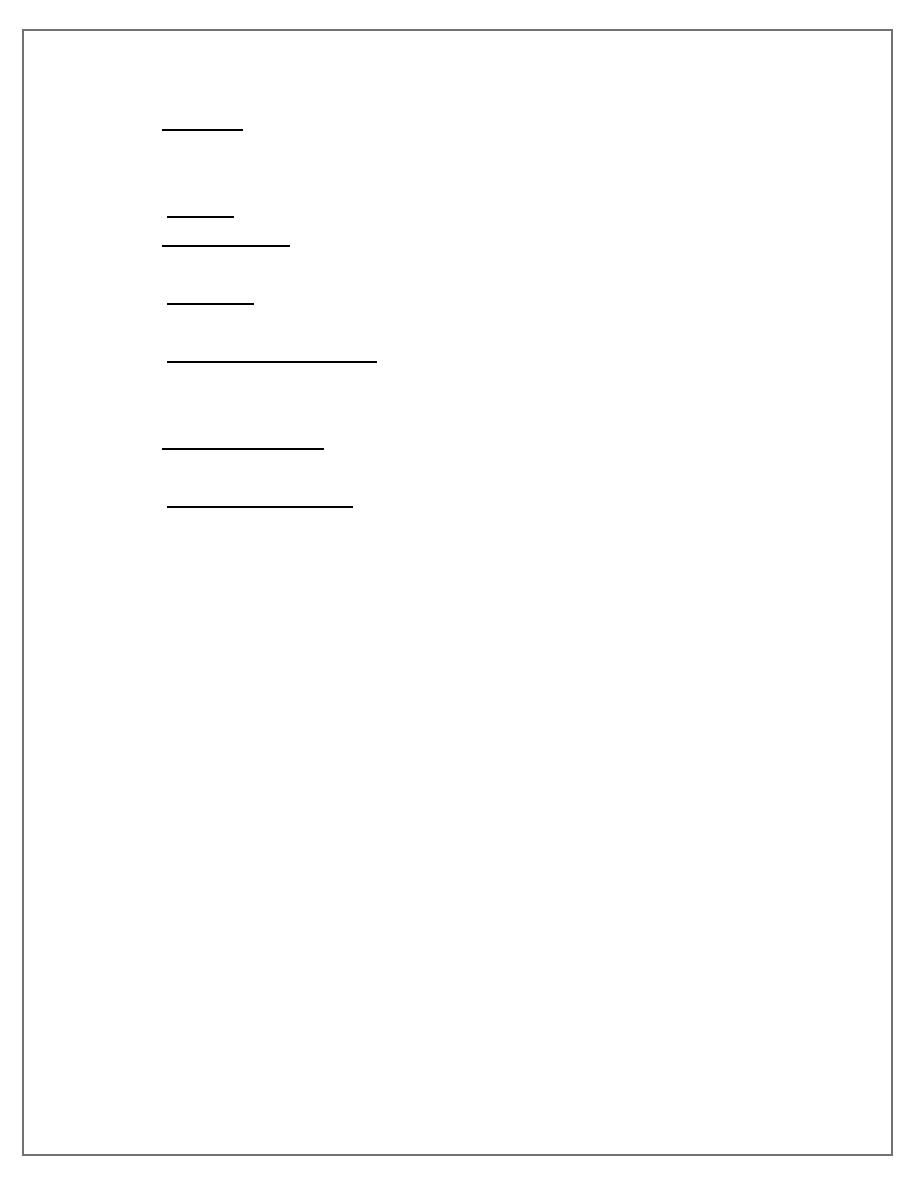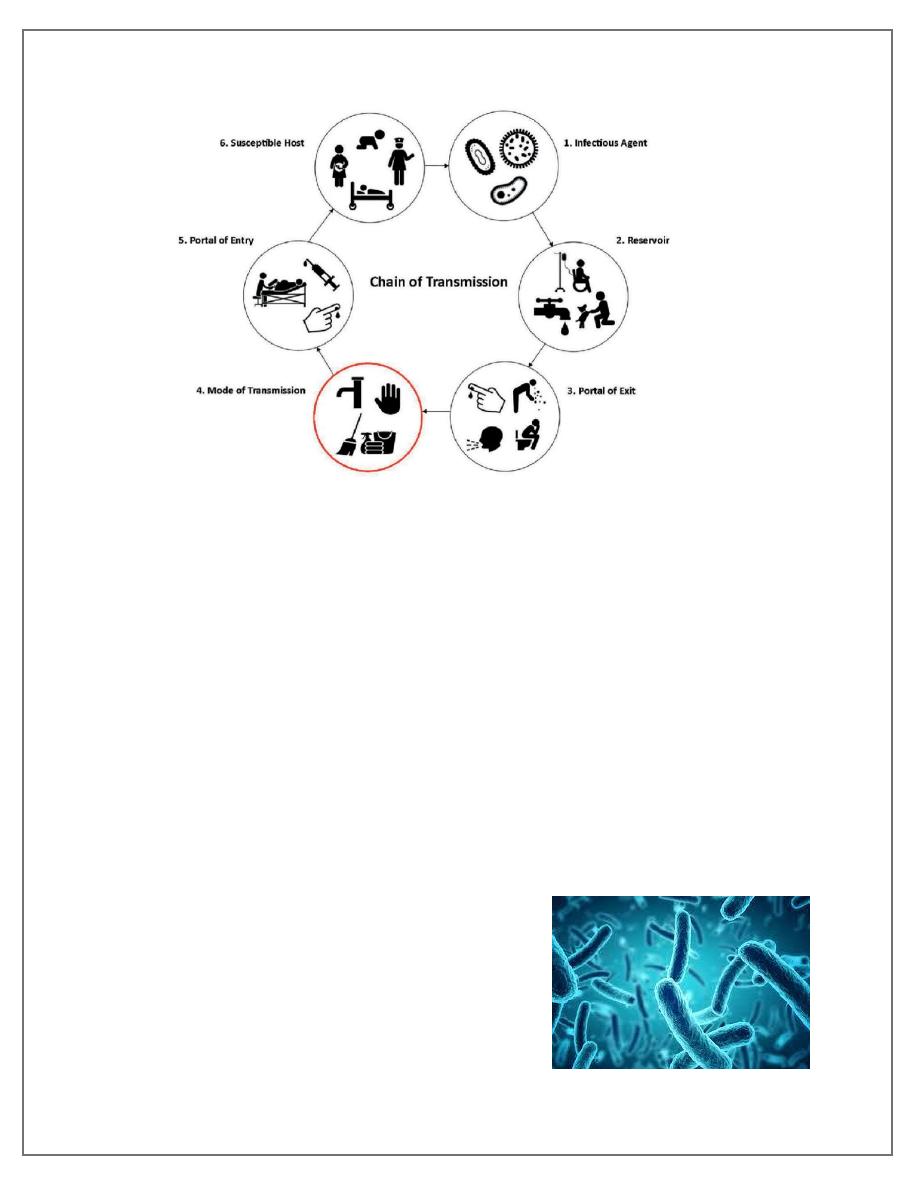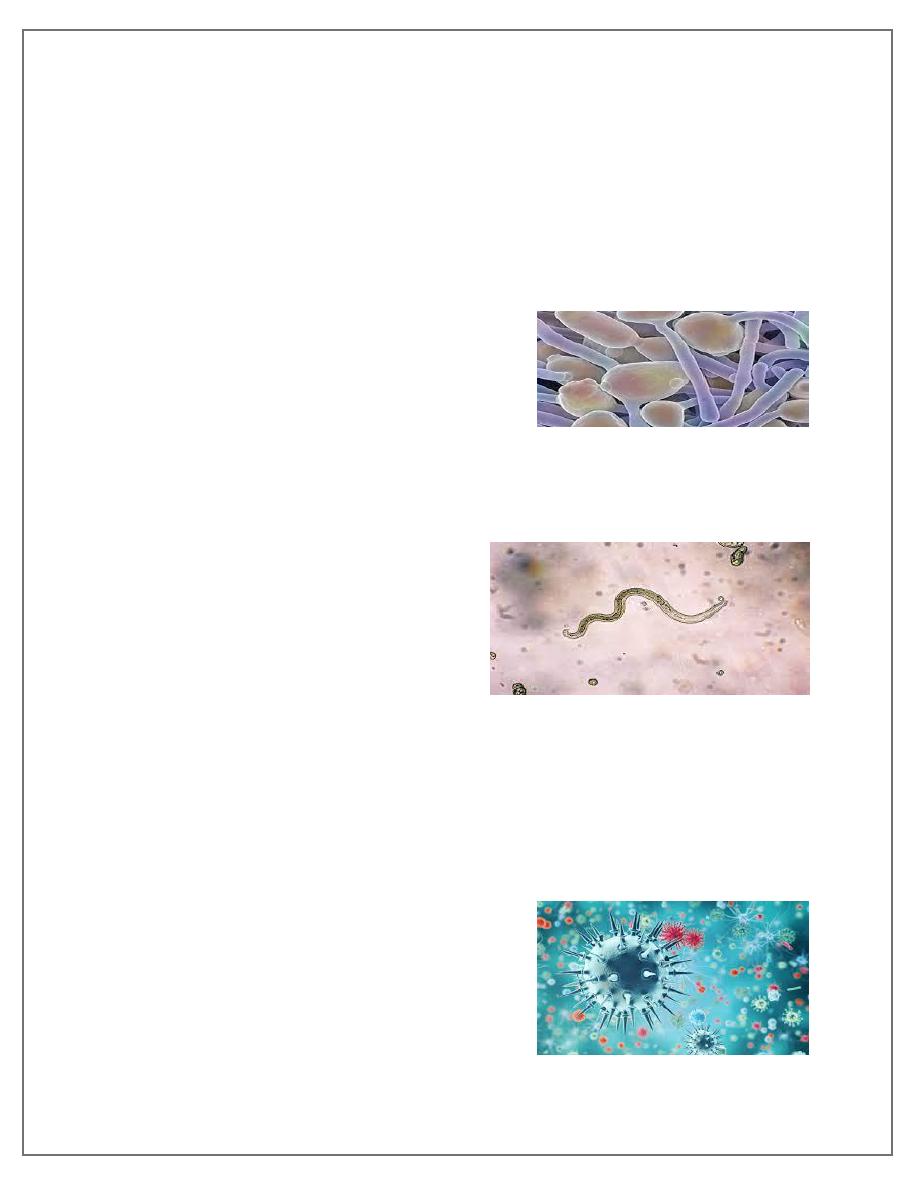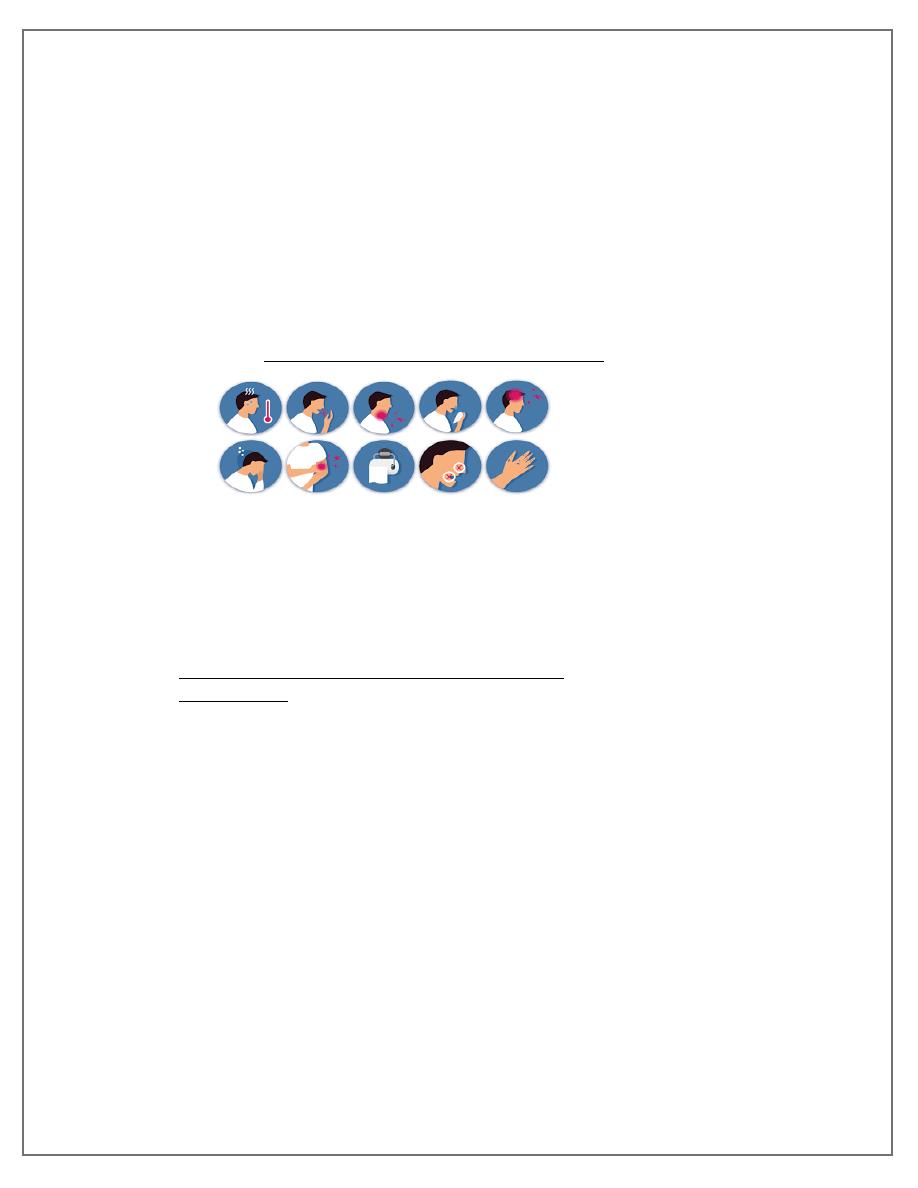
Lect. 2 Physiology
Dr. Noor Salman
pg. 1
Infection is the invasion of a host organism's body tissues by disease-
causing organisms, their multiplication, and the reaction of host tissues to
these organisms and the toxins they produce.
Disease Any deviation from a condition of good health and well-being
Pathogenicity The ability of a microbe to cause disease • This term is often
used to describe or compare species •
Virulence The degree of pathogenicity in a microorganism • This term is
often used to describe or compare strains within a species
Opportunistic infection An infection caused by microorganisms that are
commonly found in the host’s environment , its refer to infections caused by
organisms in the normal flora
Primary Infection An infection that develops in an otherwise healthy
individual
Secondary Infection An infection that develops in an individual who is
already infected with a different pathogen
CAUSING AN INFECTION • Pathogenic microorganisms cause infection
and disease in different ways.
I.
Produce poisons (toxins) which harm the body. Ex: Tetanus.
II.
Allergic reaction in the body causing runny nose, watery eyes,
sneezing.
III.
Attack and destroy the living cells they invade. Ex: Malaria (rbc’s).
The major routes of transmission are:
1-direct contact (including intimate sexual contact), e.g. soft tissue
Infections, genital herpes
2- inhalation/droplet infection, e.g. common cold, pneumonia
3- ingestion/faecal–oral route, e.g. gastroenteritis
4-inoculation or trauma, e.g. tetanus, malaria
5-transplacentally, e.g. congenital toxoplasmosis

Lect. 2 Physiology
Dr. Noor Salman
pg. 2
CHANE OF INFECTION
Infectious Agent – pathogen such as a bacteria or virus.
Reservoir – a place the pathogen can live. Examples: human body,
animals, the environment.
Portal of Exit – way to escape from the reservoir in which it has been
growing.
• Urine • Feces • Saliva • Respiratory tract • Skin • Blood •
Gastrointestinal tract • Mucous discharge • Tears
Mode of Transmission – way in which it can be transmitted to another
reservoir or host where it can live.
Can be through direct contact or airborne droplet.
Contaminated hands are one of the most common sources of direct
transmissions.
Hand washing is one of the most effective means of preventing the
spread of pathogens.
Portal of Entry – way to enter the new reservoir or host.
o
Respiratory tract, mucous membranes, and gastrointestinal tract are
common.
o
Damaged skin.
Susceptible Host – one that is capable of being infected. Microorganisms
must be present in large enough quantity to be virulent.
• The host must be susceptible.
• Individuals with an immunity to certain pathogens will not be
susceptible.

Lect. 2 Physiology
Dr. Noor Salman
pg. 3
TYPES OF MICROORGANISMS •
A. Bacteria
• Simple, one-celled microorganisms that are classified according to their
shape and arrangement.
• Cause diseases such as strep throat, pneumonia, meningitis and
tuberculosis.
• Antibiotics are used to kill bacteria – however some strains have become
resistant.
• Less than 1% of bacteria are harmful.
• There are more bacteria in our mouths than humans living on the planet.
Types of Bacteria
• Streptococci (chains)
• Staphylococci (clusters)
• Diplococci (pairs)

Lect. 2 Physiology
Dr. Noor Salman
pg. 4
B. Fungi A plantlike organism that lives on dead organic matter. Yeasts and
molds can be pathogenic.
• Cause conditions such as ringworm, athlete’s foot, yeast infections, and
thrush.
• Antibiotics do not kill fungi. Antifungal medications are available, but
expensive and may cause liver damage.
C. Rickettsia or Parasites that live
inside the cells of other living
organisms.
• Commonly found in fleas, lice, ticks, and
mites and are transmitted
to humans by the bites of these insects.
• Cause diseases such as Rocky Mountain spotted fever and typhus fever.
• Antibiotics are effective against many different rickettsia.
D. Viruses • Smallest of all microorganisms – visible only using an electron
microscope. • Cannot reproduce unless they are inside another living cell.
• Spread by contact with blood and other body fluids.
• Difficult to destroy. Not affected by antibiotics.
• Associated with diseases such as the common cold, chicken pox, herpes,
hepatitis B, influenz and AIDS.

Lect. 2 Physiology
Dr. Noor Salman
pg. 5
Three viruses are of major concern to the health care worker:
Hepatitis B – leads to destruction and scarring of liver cells. Vaccine is
available.
Hepatitis C – also causes serious liver damage. No vaccine. Often
misdiagnosed as the flu.
– AIDS/HIV – suppresses the immune system. No cure and no vaccine.
SIGN & SYMPTOMS OF INFECTION
Fever
Tachycardia
Leukocytosis
Septicemia
Others are specific to individual body parts, such as skin rashes, coughing,
or a runny nose
• bulk effect
• toxin mediated
• altered function of host systems
• host response to infection
Bulk effect The sheer bulk of organisms may obstruct a hollow organ, e.g. some
helminth infections of the intestine. Swelling of infected tissues can cause pressure
on adjacent hollow organs or neurovascular bundles.
Toxins : Toxin-mediated disease may also be caused by production of microbial
substances that damage cells, Most bacterial toxins are proteins released by the
Microorganisms damage tissues by a variety of
mechanisms:

Lect. 2 Physiology
Dr. Noor Salman
pg. 6
organism or a lipopolysaccharide complex located in the cell wall and liberated
during cell growth or lysis. A number of specific toxins have been shown to play
an essential role in corresponding diseases. They include:
• tetanospasmin: tetanus
• botulinum toxin: botulism
• cholera toxin: cholera
• diphtheria toxin: diphtheria
VIRULENCE FACTORS AND TOXINS
• Exotoxins : A type of bacterial toxin with the following properties:
May be produced by either gram-positive or gram-negative bacteria
• The action of the exotoxin does not necessarily require the presence of the
bacteria in the host
• Most exotoxins are peptide or protein
• Most exotoxins are heat sensitive (exception: enterotoxin of
Staphylococcus aureus)
• Enterotoxins: Interfere with water reabsorption in the large intestine;
irritate the lining of the gastrointestinal tract
Classes of exotoxins:
• Neurotoxins: Interfere with proper synaptic transmissions in neurons
• Cytotoxins: Inhibit specific cellular activities, such as protein synthesis
Altered function of organs, tissues or cellsMicrobial invasion can change the
function of organs, tissues or cells. These changes can be the result of
physiological mechanisms acting to remove the infective agent, e.g. increased
bowel motility leading to diarrhea, or coughing and sneezing.
The host response to infection: Usually begins with an inflammatory reaction,
and is followed by a humoral or cell mediated immune response. This may cause
damage due to swelling, increased fragility of tissues, formation of pus, scarring or
necrosis. Chronic intracellular infection may cause formation of fibrous nodules
and a state of latency from which acute infection can be re-established at a much
later stage.
